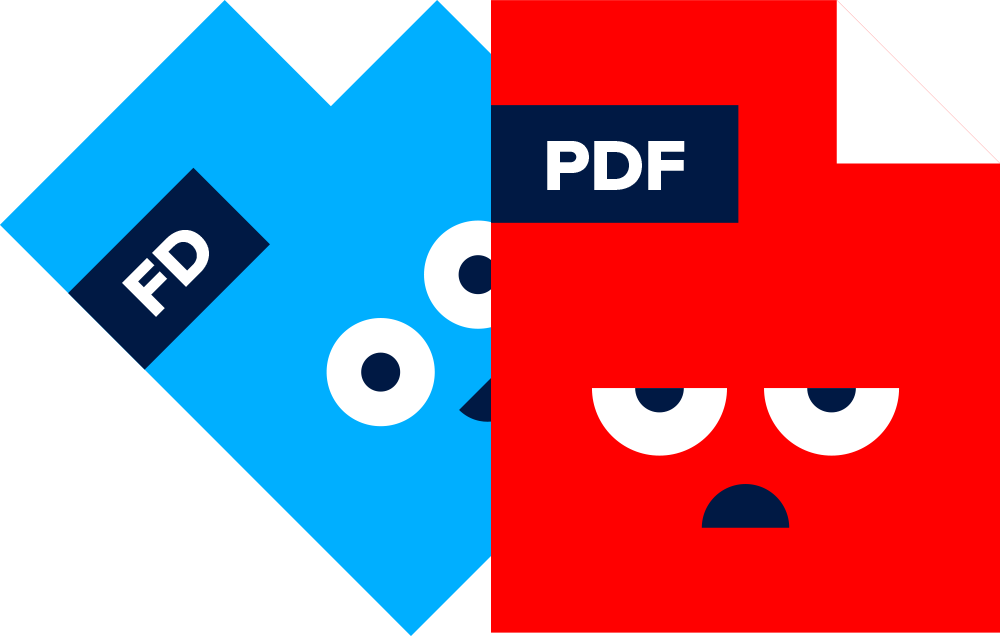Sports fans love arguing about their teams. Yet, it doesn't matter who's got the most expensive players or scoring the craziest goals; the only thing that matters is who's at the top of the league holding the trophy.
So, are you playing to your content strengths? And delivering the best of your abilities? Is your team winning when it comes to decision-making, content delivery, and mining for essential data?
Don’t go anywhere because we’re going to unpack whether interactive PDFs or web-based publications are the better content format.
Interactive PDF vs. Web publication – *whistle blows for kick-off*
PDFs have been around forever. We feel safe with them; we've supported them through the years when, without issue, they provided a quality service delivering white papers, catalogs, and online magazines via download and email and sending every file to print and publication we ever needed them to. Since their inception, they've played a great game as online documents and helped to deliver the physical versions we hold in the real world.
With plenty of packages available to help create an interactive PDF far quicker than learning InDesign—Adobe’s desktop publishing package—it was, and still can be, pretty easy, too. And for a while, they looked great on our laptops and desktops; after all, a monitor is exactly the right size to view a digital magazine or other similar publication, with animated page-turns, gifs, sound, and even videos playing on their pages.
However, as much as the PDF has tried to keep up with modern alternatives, its online applications look tired and dated. They can't quite hit the shots they used to, and they haven't got the skills to line up alongside their powerful and athletic new opposition.
What’s the difference between interactive PDFs and web publications?
An interactive PDF is the same as any other type of PDF but with a few additional cool features. With an interactive PDF, you get to include many elements we love to see that make our content more engaging, fun, and enjoyable.
For example, they can incorporate videos, sound, gifs, links, etc. In addition, their pages flip like on your Kindle or eReader, and when viewed on the right-sized screen, they're pretty good fun and present your information well.
At the other end of the pitch, the web publication, while not entirely brand new, is gathering plenty of momentum and scoring goals from every inch of the pitch—adding interest and functionality for its content creators, marketers, and not least, with its readers.
A web publication is a standalone, self-contained page, mini or micro-website, so you can utilize all the elements and technology available on any other website, keeping your readers engaged, entertained, informed, and educated. Oh, and you can track every little step they take while they do it, and that's why your marketing department loves them so much.
Why interactive PDFs suck for marketers
With marketing, your teams want to spread the word about what their business sells as clearly and attractively as possible. But they also want to know that what they're saying and posting is working. That means tracking leads and conversions and, more importantly, which areas and touchpoints drive your readers' and content consumers' decision-making.
Terrible at tracking and an own-goal for the mobile generation
As funky or professional as your interactive PDFs can look, there's little way of knowing which page drives those decisions.
We've got our eye firmly fixed on the content creation market—of course, we do; we need to know who we're playing against, after all—and we've taken plenty of our competitor's PDFs for a test drive.
As much as we've enjoyed many of the most attractive and beautifully designed papers and magazines for their content, we still know they're terrible at tracking objective metrics. Plus, most of their interactivity only works online, reducing downloadable versions to the staid and static original version. And sadly, and most importantly, when it comes to mobile, it's like someone's hidden the ball or boarded up the goal they're shooting into. They might as well kick the ball in their own net— if they could even hit it.
PDFs and mobile don’t make for a good game
The problem with interactive PDFs on mobile is that they don't scale. Without the responsive content resizing mobile viewers expect from today's tech, PDFs on your phone look like Kevin Keegan coming up against Jadon Sancho or Alphonso Davies. You might as well be trying to read their tiny pages from the stands.
There’s too much pinching and scrolling for those tiny text blocks, and nobody has time for that. Not when there are better, faster, and easier-to-read options available.
PDFs are yet to score on SEO
Another disadvantage of interactive PDF's compared to web-based publications are the challenges presented to search engines when crawling web pages for text. PDFs can be crawled in a similar way to web-based publications, they lack information found in standard web pages, including:
Most PDFs do not contain metadata valuable to Google
Whilst PDFs are probably indexed Google cannot easily determine what type of content is contained in the file without a title tag. Web-based publications are standalone web pages containing title and description tags that are powerful signals that tell google what the content is about making it more likely to rank for target keywords.
Links in PDFs are processed differently than web pages
All of your efforts in implementing a cohesive internal linking structure and collecting valuable backlinks to your PDFs will go unnoticed. Links to PDFs do not carry the same authority that comes with a web page.
Why interactive web publications rule the roost in content marketing
So, what are those better options? Well, an interactive web publication can deliver a magazine, brochure, white paper, or catalog just as well as its PDF counterpart. It uses all the tech that the latest HTML version offers. Because they operate like a micro-site, they're trackable down to the tiniest step (your marketers have just thrown their hats and scarves in the air, screaming 'gooooaaaal' at the top of their lungs).
They also scale beautifully, look every inch as good on mobile as they do on desktop or tablet, and do precisely what they need to. That’s another top-corner goal for your content creators and consumers alike; better get the metal polish out—that cup's coming home.
Final thoughts
There are countless tools available to create interactive PDFs, and as we noted, many of them do a good job, given their limitations. However, some vintage items are better remembered for what they were good at in their day instead of how they fell from grace.
We’d suggest leaving those happy PDF memories as memories and delivering your essential business information via a method that will be seen, enjoyed, and tracked on every size screen available without any failures or flaws.
Web publications will be hoisting the content creation trophy for the foreseeable future; just be sure you're supporting the right team.



